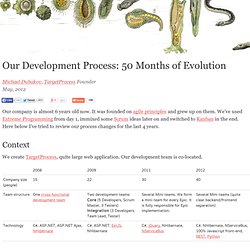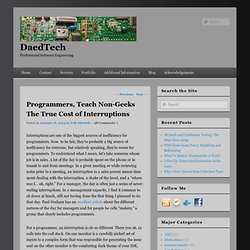

Our Development Process: 50 Months of Evolution. Michael Dubakov, TargetProcess FounderMay, 2012 Context We create TargetProcess, quite large web application.

Our development team is co-located. Observations Single Team → Mini-teams. Technology. Process Orange background - practice change caused significant problems.Green background - practice change led to nice improvements.Gray background - no changes in practice Iterations → Kanban. Points → No Estimates. Time tracking → No time tracking. Release Planning → None → Roadmaps. User Stories split. Definition of Done.
Daily meeting. Meetings. User Experience. Craftsmanship. Here are the company focus changes by year: Development practices Single branch → Feature-branches → Single branch. Pair Programming. TDD → BDD. Some stats 5200 Unit Tests2500 Functional Tests (1700 Selenium and 800 JavaScript Tests)All tests are run on 38 Virtual MachinesShort circle build time (without package) is 40 minFull circle build time (with package) is 1 hour8400 Git commits in 2011 Wrap-up Questions?
How to manage bugs in scrum. Translating my Git workflow with local branches to Mercurial. It took me a while to really settle in to a Git workflow I like to use on a daily basis.

It’s a pretty common workflow, and is centered around local topic branches and rebasing. It’s not actually much different than the workflow I used with SVN, except that I prefer rebase over merge. My typical Git workflow starts out with: git checkout –b “SomeTopic” <work work> git add . git commit –am “Commit message” <repeat last 2 steps as necessary> git checkout master git pull –rebase origin master git checkout SomeTopic git rebase master git checkout master git rebase SomeTopic (or merge, same thing) git push origin master git branch –d SomeTopic In a nutshell, all work, and I mean ALL WORK, is done in a local branch. At this point, I should note that I rarely, rarely ever need to rebase upstream changes. Anyway, I make sure that my master reflects the absolute latest upstream changes. Side note – The git “rebase considered harmful” article is 3 years old. Combining Rebase and Bookmarks.
10 Mac Productivity Tools That You Can't Live Without. If you feel like your daily computer grind could use a little oomph, we've got some.

A handful of these add-ons can make tasks that were previously awkward at best a breeze. Most of these tools for OS X are free and the rest are cheap—and all of them are essentials in our book. 1. Jumpcut We’re used to copying and pasting one item at a time—that’s just the way it works. That’s exactly what Jumpcut does. Download Jumpcut. Programmers, Teach Non-Geeks The True Cost of Interruptions. Interruptions are one of the biggest sources of inefficiency for programmers.

Now, to be fair, they’re probably a big source of inefficiency for everyone, but relatively speaking, they’re worse for programmers. To understand what I mean, let’s take someone whose job is in sales. A lot of the day is probably spent on the phone or in transit to and from meetings. In a given meeting or while reviewing notes prior to a meeting, an interruption to a sales person means time spent dealing with the interruption, a shake of the head, and a “where was I… oh, right.” For a manager, the day is often just a series of never-ending interruptions. For a programmer, an interruption is oh-so different. “HI!!! The project manager just startled you while you were getting ready to hit the next instruction and you hit “step over” instead of “step into!”
But here’s the real insult-to-injury moment. Invite the PM/manager/sales/whatever person to sit at his desk and tell him to humor you. Agile-Book. Home → Agile-Book Welcome to the The Art of Agile Development book site!

Here, you'll find a cornucopia of bonus material, such as downloadable posters, behind-the-scenes material, and new insights. For bonus features and online text, follow the links in the table of contents. Sections that include full text are marked with a star Table of Contents Preface ( Full text!) Media Reviews I can't think of a better XP practitioner-guide to date that conveys both the practices and principles of XP for novices and intermediate-level readers, and also goes beyond explaining them to provide quintessential insights, tips, contraindications, alternatives, and organizational strategies for how to overcome the many technical and organizational barriers that can stall an otherwise successful attempt adopting XP.
The Art of Agile Development by James Shore and Shane Warden is the most definitive description of agile development that I have seen. Interviews Corrections TDD Research Mischaracterized.